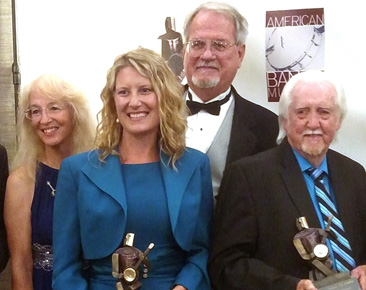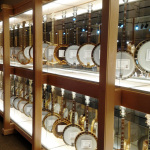
This report on the Hall of Fame weekend at the American Banjo Museum is a contribution from Alan Tompkins, a Dallas area bluegrass musician, radio host, and founder of the Bluegrass Heritage Foundation. Alan also serves on the Board of the IBMA and is integral to the events and programs of the Foundation.
 When you think of the center of the banjo universe, do you think of Oklahoma City? No? Well, before much longer, you may start to think that way.
When you think of the center of the banjo universe, do you think of Oklahoma City? No? Well, before much longer, you may start to think that way.
The American Banjo Museum, located in the historic Bricktown district of Oklahoma City, is a world-class facility honoring the rich history and vibrant spirit of the banjo. The museum’s collection (the largest collection of banjos on display in the world) contains more than 400 instruments along with recordings, film, video, instructional materials, and other memorabilia associated with banjos and players. (Most importantly for bluegrass players, the collection includes a wonderful assortment of pre-WWII Gibson Mastertones.) Galleries include replicas of primitive banjos developed by African slaves, minstrel-age instruments from mid-19th century, classic banjos from the late 1800s and early 1900s, and later instruments used in bluegrass and folk music.
The Museum’s Hall of Fame was initially established in 1998 to honor jazz-age four-string banjo pioneers as well as the contemporary artists, manufacturers, and promoters who carried on the traditions of their predecessors. As the Museum grew, the decision was made to expand its scope to include five-string performers and others involved with all types of banjos. The Hall inducted Earl Scruggs in 2014 and Steve Martin and Pete Seeger in 2015. (The Museum presently has a terrific exhibit on display that highlights several of Steve’s personal banjos.)
At the Hall’s annual induction ceremony this past weekend, they brought in two stars of the banjo world that are near to the hearts of many bluegrass players – the legendary J. D. Crowe and the Deering Banjo Company. Crowe was honored for his lifetime of achievements as an innovative bluegrass banjo player and band leader with boundless musical creativity. The Deering Banjo Company, represented by founders Janet an Greg Deering and marketing director Jamie Deering, was honored for its 41-year history of making banjos better and more readily available to players all over the world. Greg Deering offered his thoughts:
“What the American Banjo Museum is doing for the world and future of banjos cannot be understated. They are bringing players and makers, and people of all styles of banjo playing together which had not been done up to now. They are sharing the joy and history of the instrument through their work at the Museum. It is a great honor to be inducted into the Hall of Fame with so many legendary champions of the banjo. It is an instrument that has brought people together in all of its historical forms all the way back to the Egyptian days . . . to what we now know as the banjo we all enjoy today. It is our pleasure to be a part of, and contribute to, what the Museum is accomplishing for our beloved instrument.”
J. D. Crowe’s humble but irreverent sense of humor was in full flower during his acceptance speech. In addition to expressing his gratitude to the Museum for being inducted, he offered some insightful commentary to the four-string banjo fans in the crowd. “To begin with, keep in mind that we call it the banjer, not the ban-JOE. And I know that there are many talented people in this room tonight, and there are a great number of beautiful instruments in the Museum. I’d like to thank all you tenor and plectrum players for giving us bluegrassers so many fine banjos that we could put proper five-string necks onto in order to play bluegrass!” Crowe said that he was inspired as a young man by the playing of Earl Scruggs. “Without Scruggs, I wouldn’t be here tonight,” he said.
 The induction ceremony included a performance during Crowe’s segment by four-time national banjo champion Gary “Biscuit” Davis of a medley of tunes that Crowe made popular – Old Home Place, Nashville Blues, and Blackjack – all in their traditional keys without stopping. Davis used a removable capo and D-tuners to move seamlessly between the keys of B flat, D minor, and B – all at a stirring 160 beats per minute. During the Deering Banjos segment, Mark Johnson and Emory Lester performed a beautiful original duet with Johnson playing his signature Deering Clawgrass banjo.
The induction ceremony included a performance during Crowe’s segment by four-time national banjo champion Gary “Biscuit” Davis of a medley of tunes that Crowe made popular – Old Home Place, Nashville Blues, and Blackjack – all in their traditional keys without stopping. Davis used a removable capo and D-tuners to move seamlessly between the keys of B flat, D minor, and B – all at a stirring 160 beats per minute. During the Deering Banjos segment, Mark Johnson and Emory Lester performed a beautiful original duet with Johnson playing his signature Deering Clawgrass banjo.
The master of ceremonies for the Hall of Fame induction ceremony was Johnny Baier, Executive Director of the American Banjo Museum, who did a wonderful job. Baier was thrilled by the support for the event, and offered the following comments:
“The 2016 American Banjo Museum Hall of Fame weekend reflected the net result of years of re-alignment on the part of the museum. This museum, which was started for four-string banjo enthusiasts, has truly reinvented itself as the sole institution in the world devoted to all banjo types and playing styles. In addition to our Hall of Fame honorees this past weekend, we featured performances by Gary “Biscuit” Davis, Mark Johnson & Emory Lester, Cynthia Sayer, and Andy Eastwood. These performers truly showed off the musical diversity and potential of the banjo as well as the all-encompassing direction in which the Museum is heading.”
Other 2016 inductees into the American Banjo Museum Hall of Fame included Pat Terry, Jr. (Four-String Performance), George Formby of England (Historical), and teacher/author Alfred Greathouse (Instruction & Education).
If you’re traveling through the Oklahoma City area, or just a big fan of the banjo, make time to visit the American Banjo Museum. You won’t be disappointed!












